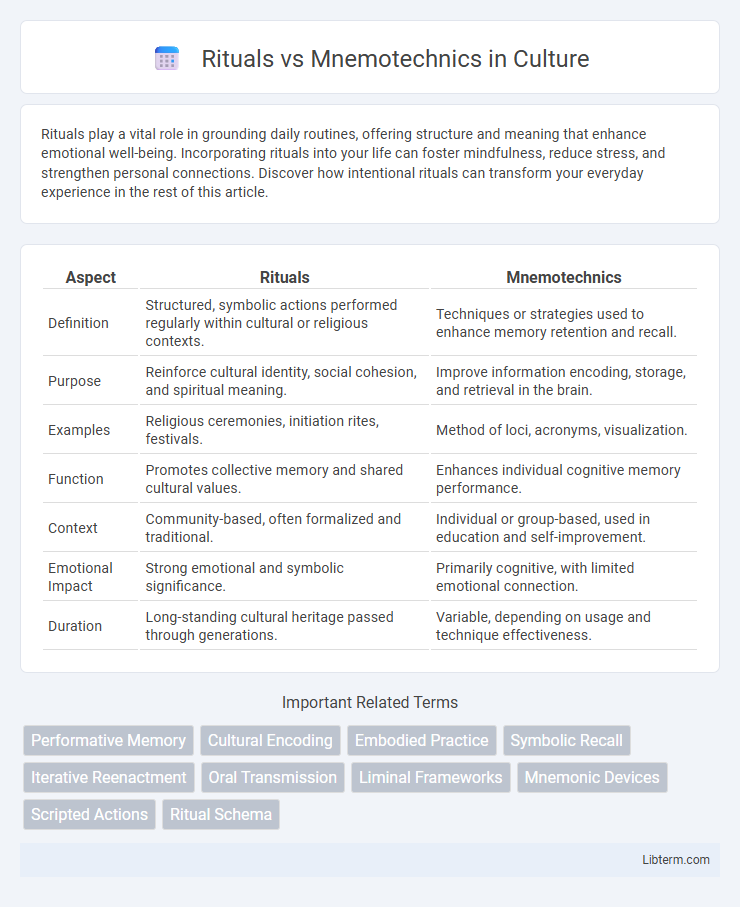Rituals play a vital role in grounding daily routines, offering structure and meaning that enhance emotional well-being. Incorporating rituals into your life can foster mindfulness, reduce stress, and strengthen personal connections. Discover how intentional rituals can transform your everyday experience in the rest of this article.
Table of Comparison
| Aspect | Rituals | Mnemotechnics |
|---|---|---|
| Definition | Structured, symbolic actions performed regularly within cultural or religious contexts. | Techniques or strategies used to enhance memory retention and recall. |
| Purpose | Reinforce cultural identity, social cohesion, and spiritual meaning. | Improve information encoding, storage, and retrieval in the brain. |
| Examples | Religious ceremonies, initiation rites, festivals. | Method of loci, acronyms, visualization. |
| Function | Promotes collective memory and shared cultural values. | Enhances individual cognitive memory performance. |
| Context | Community-based, often formalized and traditional. | Individual or group-based, used in education and self-improvement. |
| Emotional Impact | Strong emotional and symbolic significance. | Primarily cognitive, with limited emotional connection. |
| Duration | Long-standing cultural heritage passed through generations. | Variable, depending on usage and technique effectiveness. |
Understanding Rituals: Definition and Purpose
Rituals are structured sequences of actions or ceremonies performed primarily to convey symbolic meanings, foster social cohesion, or mark significant life events, often rooted in cultural or religious traditions. They function to reinforce shared beliefs, establish group identity, and provide psychological comfort through predictable patterns. Unlike mnemotechnics, which are techniques explicitly designed to enhance memory retention, rituals serve broader social and emotional purposes beyond mere mnemonic function.
Mnemotechnics Explained: Memory Tools Unveiled
Mnemotechnics refers to a variety of memory enhancement techniques designed to improve information retention and recall by associating new knowledge with familiar concepts or vivid imagery. These tools include methods such as the method of loci, acronyms, rhymes, and chunking, all of which facilitate efficient encoding and retrieval of data. Unlike rituals, which often rely on repetitive behavior rooted in cultural or spiritual practices, mnemotechnics provide structured cognitive strategies grounded in psychology and neuroscience to optimize learning and memory performance.
Historical Origins of Rituals and Mnemotechnics
Rituals trace their origins to ancient religious and cultural practices, serving as structured ceremonies that reinforce social cohesion and transmit collective memory across generations. Mnemotechnics, or memory techniques, originated in classical antiquity, notably with Greek and Roman scholars like Simonides, who developed systematic methods such as the method of loci to enhance recall. Both have historical roots in enhancing human cognition--rituals through embodied repetition and symbolism, and mnemotechnics through strategic mental encoding and retrieval frameworks.
Rituals as Collective Memory Mechanisms
Rituals serve as powerful collective memory mechanisms by encoding shared values, histories, and identities within communities through repeated symbolic actions and ceremonies. Unlike mnemotechnics, which rely on individual cognitive strategies to enhance memory retention, rituals operate at the social level, reinforcing group cohesion and cultural continuity across generations. This communal embodiment of memory ensures that collective knowledge is preserved and transmitted, stabilizing societal norms and collective identity over time.
Mnemotechnics in Individual Learning and Recall
Mnemotechnics enhance individual learning and recall by employing structured techniques such as the method of loci, acronyms, and image association to organize and retain information efficiently. These cognitive strategies leverage neural pathways to improve memory retention compared to passive ritualistic repetition, providing a systematic approach for encoding and retrieving data. Research demonstrates that mnemotechnics significantly boost long-term recall accuracy and learning speed in various educational contexts.
Comparing Psychological Effects: Rituals vs Mnemotechnics
Rituals enhance psychological well-being by providing structure, reducing anxiety, and fostering a sense of control and community through repetitive, meaningful actions. Mnemotechnics improve cognitive function by leveraging associative memory techniques to enhance information retention and recall, activating neural pathways that support learning and mental agility. While rituals primarily impact emotional regulation and social bonding, mnemotechnics directly influence memory performance and cognitive processing efficiency.
Cultural Significance: Rituals and Memory Enhancement
Rituals function as culturally embedded practices that reinforce collective memory through repeated symbolic actions, fostering social cohesion and identity. Mnemotechnics involves structured cognitive techniques designed to enhance individual memory retention by creating vivid mental associations. Both play crucial roles in memory enhancement, with rituals emphasizing communal continuity and mnemotechnics focusing on personal cognitive efficiency.
Practical Applications in Modern Society
Rituals enhance social cohesion and mental well-being by embedding symbolic actions into daily routines, making them effective for stress reduction and habit formation in modern society. Mnemotechnics, or memory techniques like the method of loci, dramatically improve learning efficiency and information retention, benefiting students and professionals alike in fast-paced environments. Both ritualistic practices and mnemonic strategies address cognitive performance but cater to different aspects: rituals foster emotional and social stability, while mnemotechnics optimize intellectual capacity.
Limitations and Risks of Each Approach
Rituals often rely on repetition and symbolic actions, which can limit their effectiveness in complex memory tasks due to their lack of flexibility and potential for superficial engagement. Mnemotechnics, while powerful for encoding and retrieval, risk cognitive overload and dependence on artificial associations that may not generalize well outside structured contexts. Both approaches face challenges in balancing ease of use with long-term retention, highlighting the need for context-specific application.
Integrating Rituals and Mnemotechnics for Optimal Memory
Integrating rituals with mnemotechnics enhances memory retention by combining the emotional and sensory engagement of rituals with the structured encoding methods of mnemonic devices. Rituals provide a consistent framework that anchors mnemonic techniques, making memory cues more vivid and accessible through repeated practice and contextual associations. This synergy leverages both procedural memory and associative learning, resulting in more durable and easily retrievable memories.
Rituals Infographic

 libterm.com
libterm.com